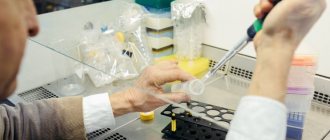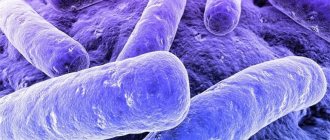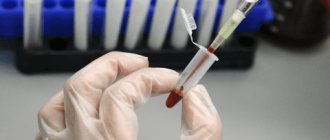Immunoglobulin is an indicator of humoral immunity. Doctors at the Yusupov Hospital prescribe an immunoglobulin M test to assess immunity, the course of kidney and liver diseases, and acute infectious diseases. The test results are interpreted by candidates and doctors of medical sciences, doctors of the highest category. Immunologists individually select treatment regimens for patients. All severe cases of impaired immune function of the body are discussed at a meeting of the expert council.
The Yusupov Hospital has created the necessary conditions for the treatment of patients who have increased or decreased IgM immunoglobulin. Comfortable rooms are equipped with forced-air ventilation. Air conditioners allow you to create a comfortable temperature regime. Patients are provided with individual personal hygiene products and dietary nutrition. The staff is attentive to the wishes of patients and their relatives. For treatment, doctors use effective drugs that have minimal side effects.
What does the element show?
Immunoglobulin m is a protein substance that is called an antibody. What does immunoglobulin M show? IgM immunoglobulins are the first to be produced in response to the introduction of infectious agents into the body, appear in the bloodstream and provide primary immunity.
Immunoglobulin M is synthesized by plasma cells. They make up 5-10% of the total amount of immunoglobulins that are in the blood serum. Due to their high molecular weight, IgM immunoglobulins are called macroglobulins. They penetrate little into tissue. The half-life of immunoglobulin M in the blood is 5 days.
The primary immune response is associated predominantly with IgM antibodies, while class G antibodies take part in the creation of secondary immunity. IgM immunoglobulin binds most effectively to complement. In order to trigger this mechanism, it is sufficient to bind the antigen with just one molecule of immunoglobulin M. Immunoglobulins M cause bacteria to stick together and neutralize viruses. The concentration of immunoglobulin M in the blood increases in children and adults suffering from infectious diseases. They play an important role in activating phagocytosis and removing the infectious agent from the bloodstream.
Immunoglobulins M begin to be produced during fetal development. They protect the baby from infectious diseases. Maternal immunoglobulins do not penetrate the placenta into the fetal blood due to their high molecular weight. If their content increases in the umbilical cord blood, this is a diagnostic criterion for the development of intrauterine infection. Immunoglobulins M also include isohemagglutinins (group antibodies), cold agglutinins, and rheumatoid factor (in the early stages of the disease).
Immunoglobulin class M (Ig M)
What is immunoglobulin M (Ig M)?
This is a class of immunoglobulins that provides the primary immune response. IgM is the evolutionarily most ancient class of antibodies. They are synthesized by plasma cells and make up 5-10% of the total amount of immunoglobulins in blood serum. Antibodies of this class penetrate little into tissues. Their half-life in the blood is about 5 days. A significant increase in the concentration of IgM in the blood is observed in a number of infections, both in adults and in newborns. They play an important role in activating phagocytosis and eliminating pathogens from the bloodstream. IgM is already produced in the fetus and is involved in anti-infective defense. During intrauterine development, mother's IgM does not penetrate the placenta into the baby's blood due to its high molecular weight. Elevated IgM content in umbilical cord blood is a diagnostic criterion for intrauterine infection of the fetus. The class of IgM immunoglobulins also includes isohemagglutinins (group antibodies), rheumatoid factor (in the early stages of the disease), and cold agglutinins.
Indications for the purpose of analysis:
- recurrent, chronic or severe infections (to assess the degree of immunodeficiency);
- suspicion of prenatal infections (test of blood from the umbilical cord);
- rheumatoid arthritis and autoimmune diseases;
- tumor diseases;
- chronic hepatitis, liver cirrhosis;
- Waldenström's macroglobulinemia (treatment control);
When are immunoglobulin M levels elevated?
- Viral infection (viral hepatitis, infectious mononucleosis).
- Early signs of bacterial or parasitic infection.
- Intrauterine infections in newborns.
- Acute and chronic purulent infections, especially of the gastrointestinal tract and respiratory tract.
- Collagenosis - rheumatoid arthritis.
- Chronic hepatocellular diseases (biliary cirrhosis).
- Enteropathies.
- Multiple myeloma (IgM type).
- Waldenström's macroglobulinemia.
- Asymptomatic monoclonal IgM gammopathy.
- Presence of cold agglutinins.
- Use of chlorpromazine.
When is immunoglobulin M level low?
Acquired deficiency:
- cytostatic and radiation therapy;
- condition after splenectomy;
- protein loss due to gastroenteropathy, burns;
- lymphoma;
- monoclonal gammopathies (not IgM).
Congenital deficiency:
- agammaglobulinemia (Bruton's disease);
- selective IgM deficiency.
Other reasons:
- taking dextran, gold preparations.
Reasons for increase and decrease
If immunoglobulin M is elevated, what does this mean? An increase in concentration occurs in the case of:
- acute viral, bacterial, parasitic and fungal diseases;
- acute viral hepatitis;
- systemic lupus erythematosus;
- autoimmune diseases;
- pyelonephritis;
- multiple myeloma.
Immunoglobulin M may be elevated in a child with an acute respiratory viral disease, or in the presence of intrauterine infection in newborns. Immunoglobulin IgM can increase with viral hepatitis and infectious mononucleosis. An increase in immunoglobulin m is an early sign of a bacterial or parasitic infection.
The reasons for the increase in the concentration of immunoglobulin M in the blood serum are:
- acute and chronic purulent infectious diseases of the gastrointestinal tract and respiratory tract;
- enteropathy;
- chronic hepatocellular diseases (biliary cirrhosis);
- multiple myeloma (IgM type);
- asymptomatic monoclonal IgM gammopathy;
- Waldenström's macroglobulinemia;
- presence of cold agglutinins.
With immunodeficiency, a specific type of increase in IgM immunoglobulins may develop against the background of low values of other immunoglobulins. It's called hyper-IgM syndrome. The disease develops when there is an inability to form memory B cells and the formation of degenerative processes in lymphoid tissue. This occurs due to a defect in certain genes, the process of transformation of which occurs on the surface of B and T lymphocytes.
A decrease in the content of immunoglobulins m indicates a deficiency of humoral immunity. The level of immunoglobulin M decreases during chronic viral infection, diseases that lead to depletion of the immune system, after cytostatic and radiation therapy.
Low levels of immunoglobulin M can be observed after removal of the spleen, with protein loss in patients with burns and enteropathies. Lymphoma and monoclonal gammopathies (not IgM) also cause a decrease in the level of immunoglobulins M. Congenital deficiency of IgM immunoglobulins is observed in agammaglobulinemia (Bruton's disease) and selective IgM deficiency.
Immunoglobulins M and G for coronavirus: how to decipher the test?
What if the value is slightly greater than one? Most likely, at some time (and probably a long time ago), you have already been ill, and immunoglobulins G have almost disappeared from the body. In general, those who have been ill in the first months have a level of G antibodies much higher than one, so you will definitely understand that you have recently had coronavirus.
“According to the observations of our center, in those who have recovered from the disease, the level of immunoglobulin G remains quite high: 30 and above. I’ll speak for myself: I got sick a month ago, my level of G antibodies is now more than 50 - high,” Karpenko gives an example.
How long do immunoglobulins last?
Usually, by the second month from the moment of encountering coronavirus, immunoglobulins M are no longer fully detectable in the blood. But most often they are not there early enough.
And with immunoglobulins G, which indicate immunity to coronavirus, everything is much more interesting. There is no clear answer to how long immunity will last.
We can say for sure that after three months the level of immunoglobulins G decreases by half, and after six months, as a rule, they are almost not observed in the blood.
“In December, anti-Covid plasma donors who had recovered from the first wave still came to us. That is, they still had immunoglobulins. But practice shows that, on average, immunoglobulins G disappear after six months,” says Karpenko.
Why some people have more immunoglobulins and others less is also a matter of scientific debate. Research by the Republican Scientific and Practical Center for Transfusiology and Medical Biotechnology shows that several factors influence:
- it all depends on the severity of the disease: those who have been more severely ill with coronavirus usually have more antibodies. This also affects the individual reaction of the immune system,
- age: in younger patients the level of antibodies was ultimately higher,
- For some reason, women produced more antibodies.
If I have antibodies, will I not get coronavirus?
With a 95% probability - yes. Again, the presence of immunoglobulin G is just one indicator of immunity. There is also T-cell immunity: “T-helper” cells, “T-killer” cells, “memory cells”. There may be no immunoglobulins, but the remaining participants in the immune response “remembered” the infection and will react if they encounter the coronavirus again. The information will go to the humoral immunity, which is responsible for the production of antibodies, and protection will work.
Indications for the study
Doctors at the Yusupov Hospital determine IgM immunoglobulin in elderly patients to assess the degree of immunodeficiency. A blood test from the umbilical cord is performed if prenatal infections are suspected. Determining the concentration of immunoglobulin m is necessary for patients suffering from rheumatoid arthritis and autoimmune diseases.
Malignant neoplasms, chronic hepatitis, liver cirrhosis, Waldenström's macroglobulinemia are indications for studying the concentration of IgM immunoglobulin. The test is done to check kidney function.
Determination of the level of immunoglobulins M
To test the content of immunoglobulin M, patients undergo venous blood sampling. When performing venipuncture, the medical staff of the Yusupov Hospital strictly observes the rules of asepsis and antisepsis. Blood is drawn into an empty tube or one containing a gel (to obtain serum).
On the eve of the study, the doctor stops medications that affect the level of immunoglobulins. After the blood is drawn, the patient can continue taking medications. In order for the results of the study to correspond to reality, the patient needs to prepare:
- refrain from eating for 12-14 hours before the test (you are allowed to drink water;
- during the three days preceding the study, do not drink alcohol;
- Stop smoking 2 hours before blood sampling.
The results of the study may be affected by the use of drugs and certain medications (dextran, gold preparations). The blood test is done within 4 hours. In order to determine the level of immunoglobulin M and get advice from an immunologist, call the clinic. The contact center of the Yusupov Hospital is open 24 hours a day, 7 days a week.
Tests for the presence of IgG and IgM antibodies to COVID-19 in children and adults
All children's medical facilities conduct laboratory tests for the presence of specific IgG and IgM antibodies to the COVID-19 coronavirus in the blood.
In order to comply with epidemiological safety measures, studies are carried out only at home, by appointment.
What does the study show?
After the virus enters the body, the human immune system begins to produce antibodies specific to the virus (Ig - immunoglobulins) - an important factor in protecting against infection. Detection of antibodies of different classes in the blood is informative evidence of a current or past infectious process, and, in combination with the results of a clinical examination, helps determine the stage of the disease or recovery. To do this, antibodies of class M (IgM) and G (IgG) are determined in the blood.
Immunoglobulins M
They appear in the blood approximately three weeks after contact with the virus in the case of an asymptomatic coronavirus infection and disappear by approximately 14-16 weeks from the moment of this contact. The presence and level of IgM antibodies in the blood can indicate a current or recent infection.
Immunoglobulins G
They begin to be produced in the body 21-28 days after contact with the virus, their level increases slowly, but can remain high for a long time (in some cases, up to several years). By the presence and level of IgG antibodies in the blood, one can judge the fact of infection in the past and determine the presence of a specific immune response - the body’s ability to recognize the virus when encountering it again.
Research method : enzyme-linked immunosorbent assay (ELISA) is a qualitative method that determines the presence of specific IgG and IgM antibodies to the SARS-CoV-2 coronavirus, which is the causative agent of severe respiratory syndrome (COVID-19).
Who is the test performed on: children, adults, pregnant women. We recommend that all family members be tested.
The study is not carried out if the patient has symptoms of ARVI: elevated or high temperature, cough, shortness of breath).
The test reveals the presence or absence of type G or M antibodies in the blood. In the case of primary testing, it is recommended to conduct a test simultaneously for the presence of IgG and IgM antibodies in the blood
Biological material for analysis : blood only from a vein.
Interpretation of test results contains information for the treating physician and is not a diagnosis. This information cannot be used for self-diagnosis and self-treatment. The doctor makes an accurate diagnosis using both the results of this examination and the necessary information from other sources: medical history, results of other examinations.
Research results:
| IgM (+), IgG (+) | Indicates the fact of infection with coronavirus with the formation of a specific immune response. The patient is less likely to be reinfected than patients with a negative result. The likelihood of isolating the virus with the possibility of infecting others is minimal. |
| IgM (+), IgG (-) | May indicate a subacute phase of Covid-19 infection. Does not inform about the presence or absence of clinical manifestations of infection in the patient, does not determine whether the patient is a potential spreader of the virus. In case of such results, additional research is required (determination of viral RNA by PCR) and self-isolation for 2 weeks. |
| IgM (-) , IgG (+) | A positive IgG test indicates the fact of contact with COVID-19 in the breach, with the formation of a specific immune response. It is assumed that the probability of re-infection in this case is significantly lower than in patients with a negative result. The likelihood of isolating the virus with the possibility of infecting others is minimal. |
| IgM (-) , IgG (-) | There is no evidence of exposure to COVID-19. Specific antibodies were not developed. It is recommended to repeat the analysis after 2-4 weeks. |
Study completion time : 5 working days.
Providing research results : the results will be provided to you by email specified in the questionnaire when taking the analysis. Please note that test results are not communicated over the phone!
IT IS IMPORTANT TO KNOW:
- No special preparation is required for the study
- In accordance with the requirements of Rospotrebnadzor, at the time of taking the analysis you must have an identification document with you (passport or other document established by law). When taking a test from children under 14 years of age, a document from a legal representative must be indicated.
- Before performing the test, the laboratory technician will provide you with a questionnaire that you must fill out.
- Immediately before the blood is drawn, you will need to take your temperature.
COST OF THE STUDY:
Venous blood collection for antibodies to COVID-19 at home – 1050 rubles.
Blood test for the presence of IgG antibodies to the SARS-CoV-2 coronavirus – 950 rubles.
Blood test for the presence of IgM antibodies to the SARS-CoV-2 coronavirus – 950 rubles.
Blood test for the presence of IgG and IgM antibodies to the SARS-CoV-2 coronavirus – RUB 1,900.
You can see more details here
DISCOUNTS FOR ANALYSIS COLLECTION:
- “Comprehensive - 10%” - for clients of complex programs
- “Close people - 10%” - if tests are taken for two or more members of the same family
- “Health under control – 10%” if tests are taken as prescribed by our doctor
- “Special – 15%” for families with special needs if the child or one of the parents has a disability










